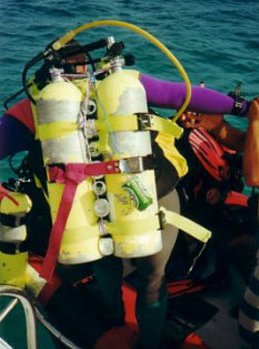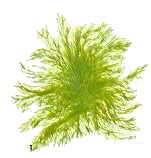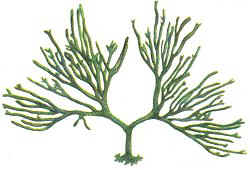Pony & Stage Bottles & Mounts
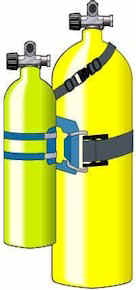
Having said all that about doubles, there are still times when it makes more sense to dive "lite". Out of the water, double tanks are very heavy and cumbersome, which makes them practical only for boat entries, where you simply have to stagger across the deck and fall overboard. At other times, and in less deep situations, you can maintain a safe redundant air supply using a much lighter "pony bottle" - a small tank of 20-40 cubic feet, weighing only about 10-20 lbs, with its own regulator that is used only in an emergency. Some of the situations where this configuration is useful to include medium-depth dives, 40-80 ft, training and practice dives ( especially in the quarry, where it is possible to reach quite deep water from the shore ), and excursions to the tropics.
Larger pony bottles ( 40-50 cf ) are also useful as "swing bottles" for carrying special decompression mixes, while the smaller ones are small enough to actually take with you when you travel. Most airlines will allow it in checked baggage if you remove the valve. This is very useful since many tropical destinations are not equipped to provide the kind of safety equipment that we take for granted here. The smallest pony bottles are really not big enough to get you out of trouble on a deep Jersey dive, however.
The pony bottle is usually attached to your main tank by some sort of bracket or harness. The best one on the market is another ingenious AquaExplorers design, the Ultimate Pony Bracket, pictured above. This compact and simple design is solid and secure, yet allows you to easily transfer the pony bottle from one tank to another between dives. All of the hardware attaches semi-permanently to the pony bottle, with nothing attached to the main tank. For air travel, simply slip out your pony bottle and leave it home, and install a rental at your destination, or take the whole thing along. This bracket is also available from Dive-Rite and Aqualung.

A stage bottle is a small auxiliary bottle that carries decompression gas. Take a technical diving class to learn how to rig and use one like this.
The one situation in which I would not recommend using a pony bottle is shallow shore diving. For slogging down a sandy beach or climbing rocks in full regalia, the lightest possible configuration is not just desirable but essential. Air redundancy is not really necessary in water that is only 15-20 ft deep - in the extremely unlikely event that you run out of air, there is an infinite supply just a few feet up. Shore dives like this also usually present many opportunities for entanglement, from fishing line to your own flag line, as well as currents and surges. All of these are good reasons to strip your configuration down to a streamlined lightweight working minimum for this kind of diving.
One consideration that seems to be seldom discussed is what to put in your pony bottle. There is no question in my mind that the only thing that belongs in a pony bottle is AIR. Filling your emergency air source with any of the typical depth-limited Nitrox mixes, 50/50 deco mix, or (worst of all) pure oxygen is simply courting disaster. This is because, depending on the mix, the pony bottle itself could become lethal at depth, either to yourself or to someone else, and is therefore no longer a safe and usable backup under all circumstances. People have died from making the mistake of using a pony bottle with the wrong mix at the wrong depth. If you want to use it as an emergency air source, then the only safe thing to fill a pony bottle with is air. If you fill it with something else, for example as a stage or "swing" bottle with a decompression mix that is not breathable at your intended depth, then it can no longer be considered a redundant backup, and you should make other arrangements.
Pony bottles of different sizes vary little in price and are often not much cheaper than full-sized tanks - clearly the cost of the manufacturing process far outweighs the cost of the materials. Steel pony bottles are available, but at twice the price of aluminum, the tiny advantage in buoyancy is simply not worth it. Even aluminum pony bottles are marginally negatively buoyant.
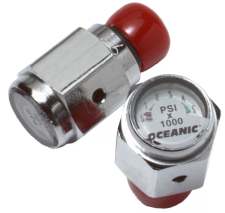
A useful item is a small 'button' pressure gauge for your dedicated pony regulator. This lets you verify your pony bottle pressure quickly without having to swap regulators around.
A final word here is on a product called "Spare Air", often seen on television shows like Baywatch. This is a very small pony bottle of less than 3cf, with an integrated regulator. This is simply not enough capacity to get you out of trouble should you ever really need it. If anything, this device merely gives its owner a false sense of security that is more dangerous than having nothing at all !
DIR
Pony bottles are forbidden, except as stages. Senseless.

